Op-Ed
‘Everyone Became More Powerful’: Simone Leigh and Rashida Bumbray on How They Built the Landmark ‘Loophole of Retreat’ Conference
The gathering in Venice was a labor of love built on decades of relationships. Its impacts are still unfolding.
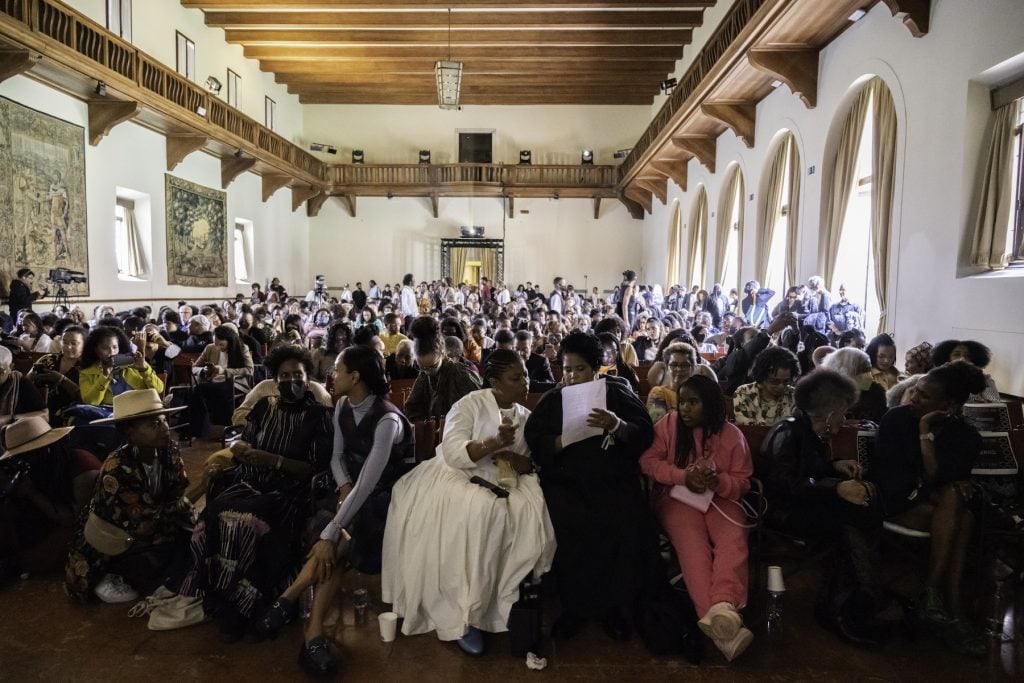
The gathering in Venice was a labor of love built on decades of relationships. Its impacts are still unfolding.

Laura Raicovich &
Simone Leigh &
Rashida Bumbray

“Everyone Became More Powerful” is a conversation commissioned by PROTODISPATCH, a digital publication featuring personal perspectives by artists addressing transcontinental concerns, filtered by where they are in the world. It was originally published by the international nonprofit Protocinema and appears here as part of a collaboration between Protocinema and Artnet News. The other publication partners of Protodispatch are Argonotlar.com from Istanbul and GroundControlth.com from Bangkok.
Below, Simone Leigh and Rashida Bumbray discuss an intertwined practice of building cultural infrastructures with care, friendship, and generosity, with Protodispatch editor Laura Raicovich.
***
Laura: An important aspect of the conversation I have witnessed unfolding over the past several years between the two of you, one that has been ongoing for a very long time, has been about building cultural infrastructure. You’ve both been enacting ways of working, being, and doing that do not abide by established rules. And that’s profound. Building infrastructures that allow for undoing and remaking, like the “Loophole of Retreat,” is so necessary.
Let’s start by going back to the first “Loophole of Retreat.” What inspired you to organize the conference in the first instance at the Guggenheim in 2018?
Simone: Building this platform was a very natural process at the Guggenheim because I was so supported there. It was one of the most organized museums I’ve ever worked with, and I was very close to Katherine Brinson and Susan Thompson. I had some experience with the Guggenheim’s commitments to education because I used to interact with their Education Department as a children’s art teacher when I worked for Studio in a School.
Originally, I thought I’d call “Loophole” “Carte Blanche” because I wanted to have a conference that didn’t have a focus on Blackness or really anything specific in the title, and that didn’t really have a title at all so that people would have to focus on the authors instead of some specific idea. I wanted to address the absence of the intellectual work of Black women as fodder for the making of and experience of art.
In the art world there was this assumption that if I’m talking about my life, then “it’s about gender.” If I’m talking about my life, then “it’s about race.” It follows that these are specific minoritarian concerns and, therefore, unnecessary, or special interest at best. That’s a smear that’s been used for so many years. I’m tired of that. I also have made a point of describing Black women as my primary audience.
I realize in retrospect that this was the first step to building a platform. There were very important theorists—Sylvia Wynter, Hortense Spillers, Saidiya Hartman, and Christina Sharpe—who were not considered as essential for contemporary art as, say, Foucault or Hannah Arendt. They were saying and doing things so pertinent to so many folks working in the art world. Outside of a few interventions—for example Leslie Hewitt and Omar Berrada’s critical sessions over at Cooper Union (Intra-Disciplinary Seminar public lecture series)—these women were largely being ignored as core curriculum by the art world.
I also liked the experiment of letting intellectuals choose their own topics and operate more like artists as opposed to these conferences that are very rigid in their focus. I thought that would be interesting. So that was my part. I collaborated with Saidiya Hartman and Tina Campt who both worked on “Loophole of Retreat Guggenheim” and its subsequent publication in e-flux. But what happened in Venice is really Rashida’s work. She organized the “Loophole of Retreat Venice.” For me, it was building the platform and bringing it to Venice. Making it happen. That became the big job, which was a new job for me. But I feel like I grew in the process. Yeah. You know, I really had to fight for it.
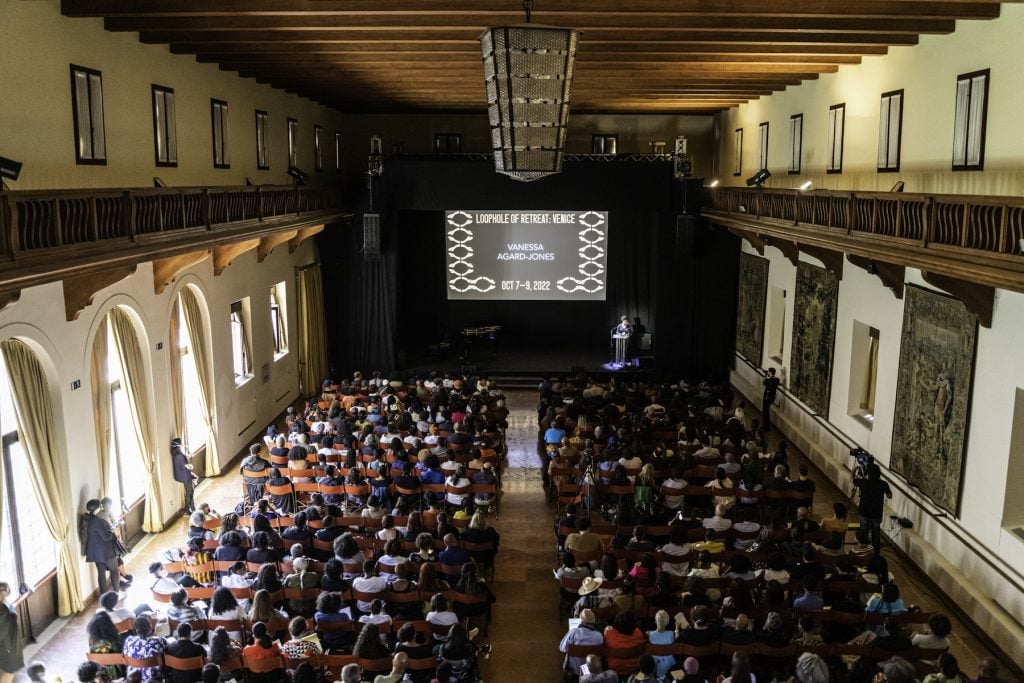
Lorraine O’Grady & Simone Leigh at “Loophole of Retreat Venice.” Photo by Claudia Rossini.
Laura: Somewhat weirdly, the experience of “Loophole of Retreat” in Venice, as a physical place, was the ultimate “Loophole of Retreat.” Rashida, can you talk about the way you conceptualized the conference unfolding in this particular city, how you imagined organizing the spaces of the conference to create such a specific atmosphere?
Rashida: One of the things that was so incredible was that women from all over the world got to be in Venice during the Biennale, to see the American Pavilion, to see the Scottish Pavilion, to see these pavilions that, for the first time, were presenting the work of Black women. I think there was this question early on about whether people were going to come. Which was shocking to us because, one, we had been at the first “Loophole of Retreat,” which was sold out to the rafters. And then two, we knew that everyone wanted to come to Venice to see the American Pavilion. And so people were trying to decide, should I come in April? Should I come for “Loophole of Retreat?” Or should I come to both? We just knew that the real question would be, “How are we going to fit all of these people?” as opposed to, “Will anyone show up?”
We also focused on how to make sure that the experience was fully considered for, as Simone says, the Black women intellectuals who were invited, that they had full freedom, and that the invitation was equitable for each person. So if you were a performer, we provided both time to perform and made sure that there was real technical support. We built a stage in the middle of a former pool, which was really the genius of our partners in Italy (A Consulting), who were incredible and completely understood what we were doing from the very beginning.
As Simone said, she really fought for “Loophole” to be a part of her American Pavilion project, which meant she personally hired people to work on this. We had a full team because Simone created that infrastructure within her studio. So Susan Thompson was the link between the Guggenheim and Venice. And Greta Hartenstein, who used to work at the Whitney overseeing performance, was there to organize the performances as a technical director. And then Daphne Hernandez, who worked with me at Open Society Foundations, had been in the music industry. So we had all these women working to ensure that everyone had what they needed and that we were able to pull it off at a high level.
You talk about Venice as the ultimate loophole. And it’s interesting because the first time that I came to Venice in 2015, it was because Thelma Golden got a grant from the Ford Foundation to bring ten Black curators. And it was such a coveted invitation because, if you’re not coming from a level of privilege in the art world, you may never have the opportunity to see the Biennale. So I think the distance between what happened in 2015 and last fall is really important. It was incredible to see a thousand Black women from such diverse positionalities within art show up, whether they hailed from academia, whether they were curators, or whether they were artists.
Everyone who attended “Loophole” could have been a speaker or performer. That was one of the most incredible things about the audience. And Lorraine O’Grady said that she felt like she was “speaking to herself,” which was both hilarious and also wonderful. She said that every time she told a joke; she knew the people around her would get it immediately without explanation.
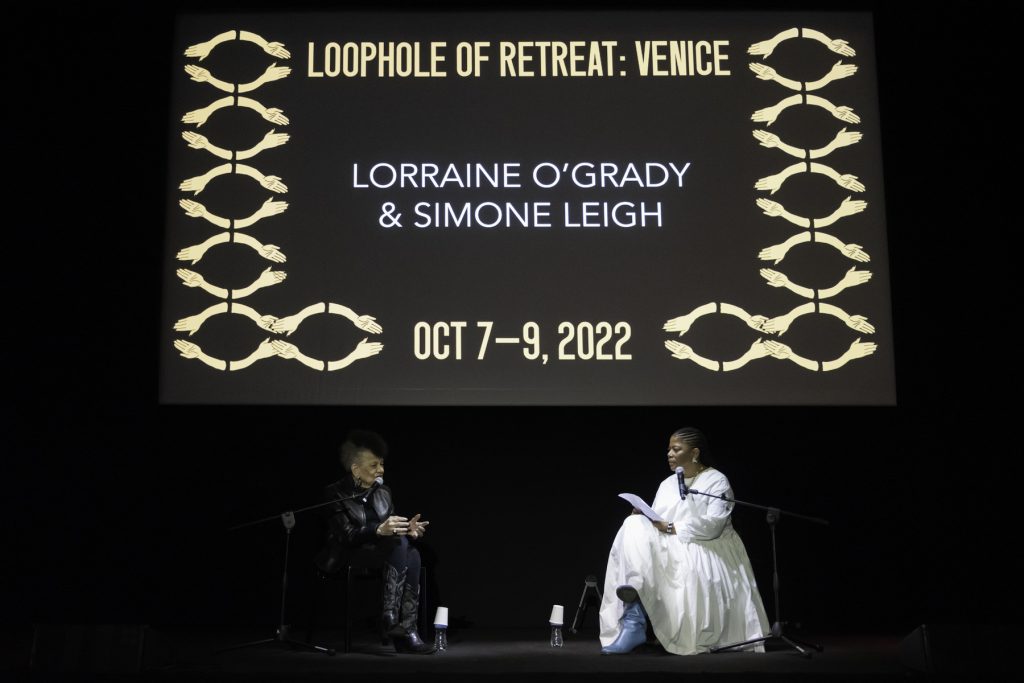
Lorraine O’Grady & Simone Leigh onstage at “Loophole of Retreat: Venice.” Photo by Claudia Rossini.
Simone: We were able to build a sense of comfort and community that we normally don’t have in these spaces because we’re normally so isolated from each other.
Laura: Loophole dispatched the narrow and flat view of representation in the most profound ways. Now that it’s been nearly a year since you opened the American Pavilion, Simone, and six months since the last “Loophole,” what do you think when you reflect on it? Did it meet your expectations? What happened that you didn’t anticipate but loved?
Simone: My exhibition at the Pavilion, as well as the “Loophole of Retreat,” were successful beyond my wildest dreams. It did cost me, however, and I am wrapping up a year of self-care behind it. I’m really fortunate to have been able to make the time and space to really recover. But the reason I think it was successful is because I’m 55 years old, and I wasn’t 35 when this challenge came to me.
Laura: Can you unpack that? Because I think you’re saying something really important.
Simone: At this point in my career, I know who I am as an artist. I understand my strengths and limitations. It’s not something that I could be pushed around on. I’m clear. Rashida and I are going on two decades of collaboration, for example. We know who we are to each other. I have relationships that thread through multiple experiences.
This being said, it was the actual self-knowledge and emotional resources that were the most important thing to get through the process because the stakes were so high. The costs were high, and for everyone connected to the project, it felt like the biggest opportunity in their careers. And this created a very difficult and confusing kind of terrain.
If I had been younger I could have been steamrolled by one entity or another. It would have been hard to avoid. But in my 50s, I’ve already raised a girl in New York City. It’s really hard to scare me, you know what I mean? Or to make me feel overwhelmed because I raised a girl in New York as a relatively poor person while making art! There’s nothing the art world can throw at me that’s harder than that.
So I think it helped that my career was not accelerated when I was young. So many people helped me all along the way, and I’m so fortunate for this, but I wasn’t handed my career. I had to really fight for it. Being this age, I think it just put me in the right frame of mind to accomplish this task.
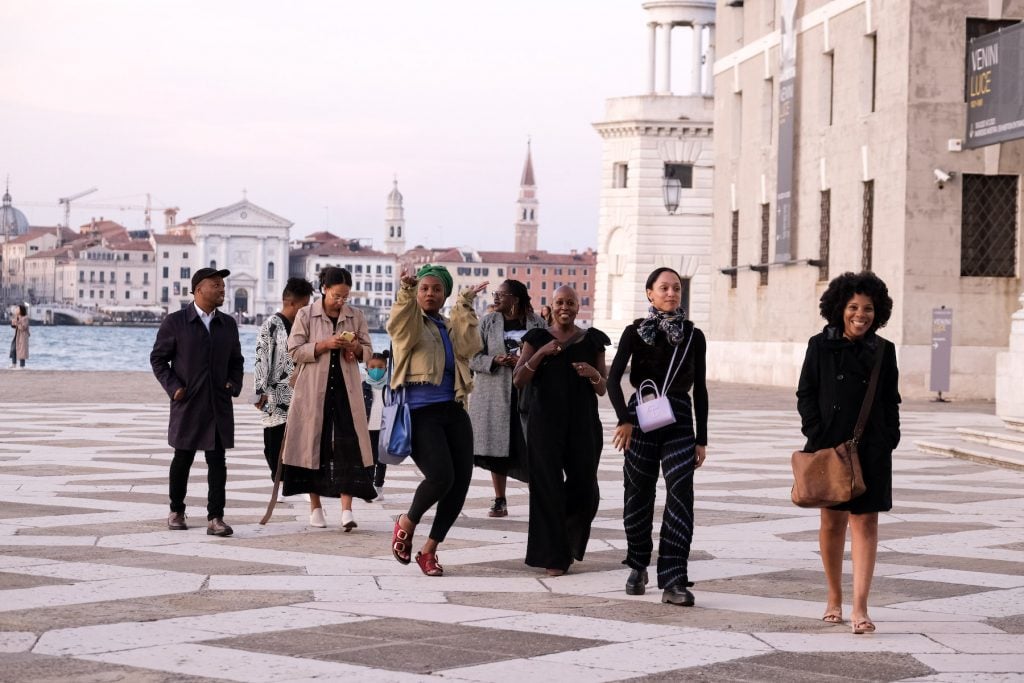
Jon Sesrie Goff, Madeleine Hunt Ehrlich, Vanessa Agard Jones, Georgie Mae, JaTovia Gary, Maboula Soumahoro, Aimee Meredith Cox, Legacy Russell, and Deborah Anzinger in Venice. Photo by Laylah Barrayan.
Laura: This is such an salient point. And one of the things that is hugely impressive about the way that you have navigated this whole period in your career, I would say, is the intense intellectual and creative generosity that you have woven into the work that you’re doing. And that goes obviously beyond the physical artworks, but not excluding them. I’m thinking about your film work, the collective works, I’m thinking about so many aspects of the work you and Rashida have done as long-term collaborators. How has that impacted you? How did that ongoing generosity of intellect, of spirit, of creativity, of resource sharing, and of all kinds impact the way that you approached this work in Venice in particular?
Rashida: I think the most generative aspect of my relationship with Simone is that she trusts me. And I’m so grateful that Simone trusted me implicitly, especially for something that was as important as “Loophole” in Venice. Simone allowed me to really be in charge of who was there, how we organized it, and what the days looked like. And it was such an incredible gift for me. I still really marvel that you trusted me, Simone, to make a project at this level.
But as you said, we’ve been working together for over 20 years. And Simone has been there for the things that I’ve done, particularly with my work at Open Society Foundations. She came to Marrakech, where I organized a meeting of artists from around the world. So I feel like we have a shared ethos about how we center the Global South and how we center Black women.
You know, there are so many kinds of intellectual work. This really allowed for an opening around what “Loophole” could be. We knew that it would be a global gathering and was inspired by historical events like FESTAC 77, for example, and also inspired by our work with curator Bisi Silva when we went to Senegal for ASIKO in 2014. We understood that bringing people together is intense intellectual work, which is really important to everyone’s practices. And this kind of interdependence, as well as elevating Black women who are so influential aesthetically and intellectually yet are somehow overlooked, is an ethos that Simone and I share.
“Loophole” in Venice was the ultimate way to solve all of these things by giving people this platform. And the people we engaged were at many different levels in their careers and levels of visibility, and all of them are doing integral work. But because of the way that the art world works and because of the way academia works, they might not already have an appropriate platform.
One of the things that I loved about the first “Loophole” was that, instead of lamenting the lack of appropriate platforms, it just created the space that was needed. That’s what we did again in Venice. We said, “These are women who are important to all of our work, whether they are working in performance or film or poetry. How do we not only give them to each other and create a space where they can see each other, but also create a space where the world can hear from them directly?” We were fighting against being unnamed references, something that we’ve all suffered as Black women making art, or working in academic spaces, or, in my case, even in philanthropy. People really think that you’re source material or something and that they can just borrow your ideas without crediting you.
And I think that “Loophole” really means that these women and their ideas are documented for the rest of time, whether it’s on YouTube and the livestream or the book that we’re going to create. It is a really important political gesture, especially because this is such an intense moment for women’s rights in the world. It’s such an intense moment on many levels. We talked about the protests in France; it’s an important moment for workers’ rights in the world. It’s an important moment for so many political urgencies that impact Black women. And as the Combahee River Collective told us, if Black women have rights and have platforms and resources, then we know it will mean that we all do, right?
Simone has often talked about Black women as a primary audience for her work. And that’s why. You can see how different the moment of “Loophole” in Venice was from even ten years ago. That is really incredible. And yes, the whole experience surpassed our wildest dreams in terms of the success of what we thought it could be. And in many ways, I struggle to describe it because I think it’s something that’s actually indescribable.
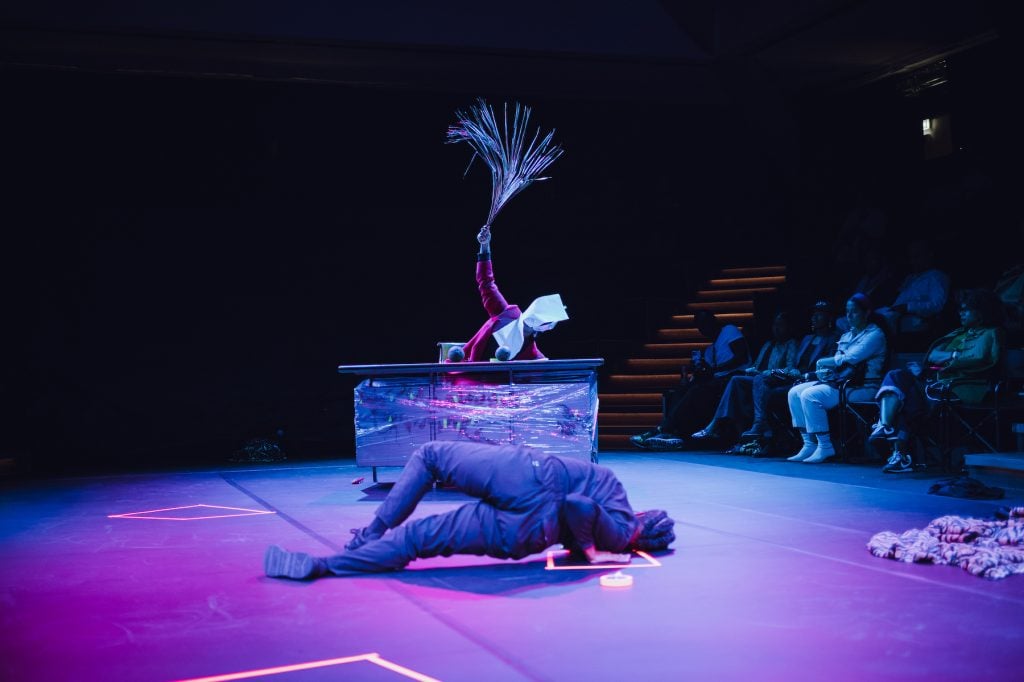
Las Nietas de Nonó perform during Loophole of Retreat: Venice, October 9, 2022. Photo by Glorija Blazinsek.
Laura: And its impacts are definitely still unfolding.
Rashida: Yes, still unfolding and hopefully will inspire things to come.
Simone: I just want to say one thing, which I think is true for both me and Rashida. Rashida did this thing after 25 years, not just two. This is really a life’s work. And I feel the same about my exhibition at the Pavilion. Lessons and relationships going back decades supported me to get this work done. And I feel like this was very much on display.
Rashida: Absolutely. I think so, too. I love that you said that. There were friends that I grew up dancing with who were at “Loophole.” And I think some of the principles that we learned in dancing school, like the idea of dancing “full out” is always at play. Full out, because they would tell you, “No marking, dance full out!” And this is something that I take into the art world. I ask myself, “What is the fullest version of myself?”
How do I bring this fullness to everything? To curation? How do I bring myself to creating the emotional tenor of a space, which I think was really important at “Loophole.” We wanted people to feel comfortable.
For example, my best friend, Gingie McLeod, who I have known since Montessori school, called it the safest place she’d ever been. This was so special because we were in an Italy that had just elected a fascist president. I never thought that Europe would be the safest place for a group of Black women, but somehow, we made it so. We were very intentional about each aspect of the conference. There was a film room. You could sit with many different films by many of the participants, some of whom were unable to attend or didn’t speak directly— Tourmaline’s film was being screened; Alberta [Whittle], who had the Scottish Pavilion, her film was also there.
There was a room that was just for rest. You could sit and catch up on your email and not have to take a boat all the way back to the hotel. Some people used it to take a nap. And children were welcomed, and there were spaces for them as well. This all came out of imagining a dream space that truly centered on us. And I think it was hugely successful; even though it was painstaking for us to consider all of these details, we figured it out.
Laura: You had children, you had elders, you had people from so many different geographies with different levels of jet lag! I remember going to the first day and just seeing this stream of Black women walking down the Riva dei Schiavoni, you know, the main drag on the waterfront in Venice. And I was like, “Oh, I know where I’m going.” There were women greeting us at the boat, and so many reunions were unfolding. It was a singular experience. And that’s even before we got to the conference! So the things that happened on the stages and in the performance areas and everywhere in between were just so beautiful.
And then what happened with the presentations. I really felt your desire to under-define what people might contribute to foreground the self-determination that is so central to both the Pavilion and “Loophole.” Of course, you had guideposts, like the directives: medicine, maroonage, manual, sovereignty, and magical realism. They’re meaningful, each of them, to the kind of cosmology that you were building at “Loophole.” But they weren’t overly prescriptive. I think they were helpful, especially for the people who are accustomed to going to conferences that not only have subjects, but where each panel is named and each speaker has a theme.
So I wanted to ask you both about what’s coming next. Is “Loophole” going to continue, maybe in a different geography? Might it have a different form? It was so powerful to be in that audience at the Guggenheim and again in Venice. I would love to revisit those experiences in a different way. How are you thinking about creating the book?
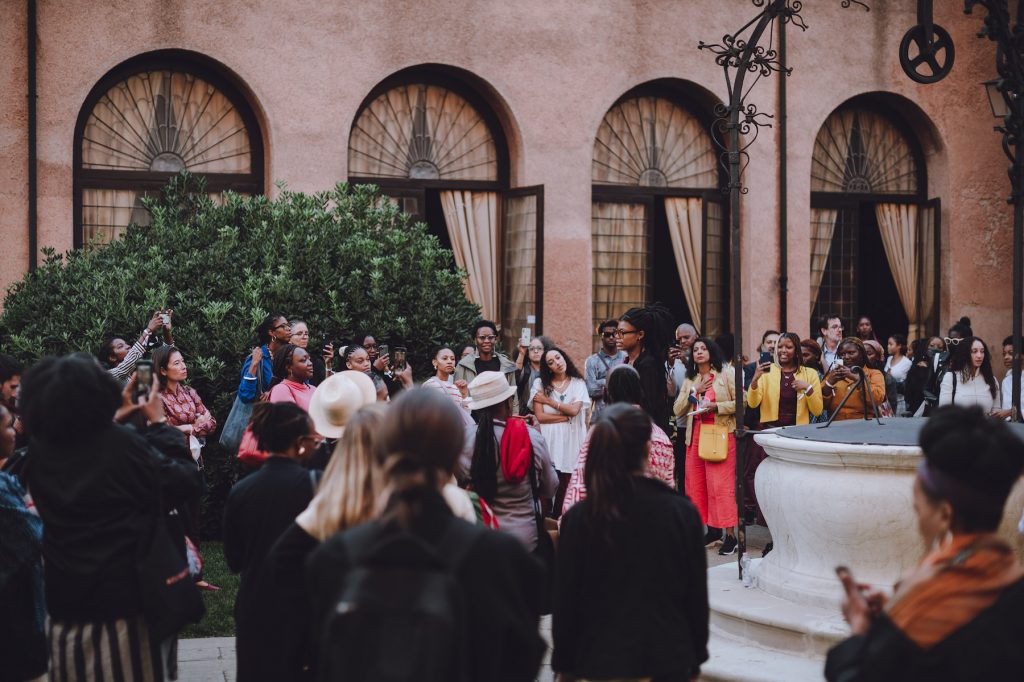
Spelman graduate & poet Ming Joi Washington recites “Laboring Woman” Photo by Glorija Blazinsek.
Rashida: I think with the book we really want to give people, like you said, an alternate way to experience “Loophole.” And we also are thinking of including the essays from the first “Loophole” as well, because Tina Campt, who co-organized that first iteration with Saidiya Hartman, and who also advised on this iteration as well, actually did the work to edit and publish them online. So we want to consider putting those essays in the book as well.
As to the question of another “Loophole,” we’re trying to figure out what’s necessary and not just recreate it for the sake of recreating it. Simone can also speak to this. We want to be sure it makes sense because one of the hardest parts of it was the fundraising. And because Simone had to do another whole job last year on the fundraising, that’s definitely a consideration.
Simone: I’m grateful for that experience but I do not want to be fundraising all the time. [Laughter] Also, I’ve always been very resistant to the idea that if something was great, we have to do it again and again. I’ve walked away from a lot of successful projects because it was time. The Be Black Baby party is a good example that could have gone on forever, or Black Women Artists for Black Lives Matter could have gone on forever, and there were different reasons why those projects really just needed to close. They had their day, and I feel like that’s the reason why it’s art and not some form of capitalism.
I would never want to feel that we did something to dilute the power of the first two “Loopholes.” I would want it to be just as strong if we did do it again. I think that all of our attention right now, or all my intention, is really focused on getting it documented, because I agree with you, there’s a whole community of people out there that I realize my work will only reach if there are books. Videos and even my exhibitions aren’t necessarily going to reach what I think is a significant part of my audience. So I’m thinking about making some books and maybe taking charge of a little bit of the language around the work and the way it’s described.
Laura: I think that’s really wise. We all have books on our shelves that we go to all the time; plus, it provides a different valence to the work as well. Of course, there was something ineffable in the air, the energy of the space, that is just not transferable to a book form. But that doesn’t mean a book couldn’t provide a totally different valence of meaning to the project. Looking at a series of texts and images and seeing them as potential (or actual) conversations that are happening side by side with one another. There were incredible coincidences of language and histories and conversations between all of these amazing people at “Loophole” that I’d like to revisit in a material book.
I have one more question, and it goes back, Simone, to something that we talked about a while back. It was your mic drop moment at the 2015 Creative Time Summit, also in Venice, when you said, “We may need to go back underground.” Can you speak to your thinking and feelings then and what the relationship between that moment and being back in Venice for “Loophole” and “Sovereignty?”
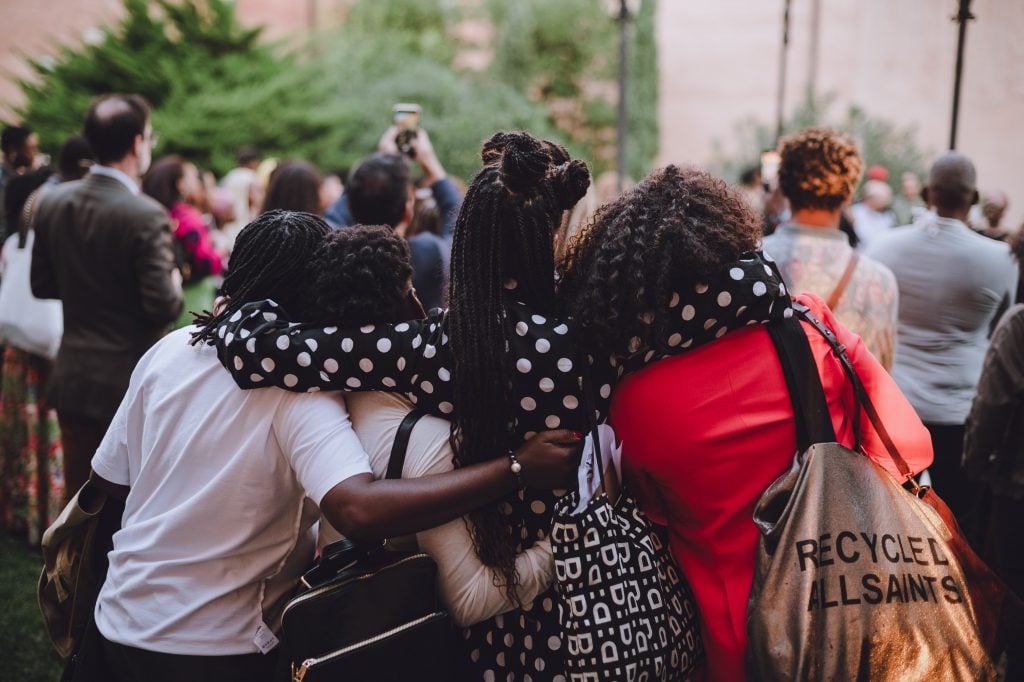
Phoebe Boswell (center) & friends. Photo: Glorija Blazinsek.
Simone: I’m just thinking back that I was there at Creative Time without Rashida to talk about the Free People’s Medical Clinic (FPMC). Now, why wasn’t Rashida there? That’s a really good example of the kind of erasure that she and I have had to endure our whole careers, and that I’ve witnessed happening to so many others.
I was talking about going underground as something that I had realized that was specifically important in African American traditions of resistance. During the process of creating the FPMC I learned about the work of the United Order of Tents. They have worked mostly in secret for over 150 years. Also several people engaged in Bible study were gunned down in Mother Emmanuel church while we were organizing FPMC. After Nat Turner’s rebellion, that same church went underground and met in secret for 35 years after Black churches were banned in 1834. Working underground is an essential tool.
I tried to reenact this work at New Museum with “Home Economics,” wherein a group of girls studied herbalism, feminism, and Taiko drumming while the museum was closed. Aimee Meredith Cox worked with me on this project. I didn’t allow photography because I see it as a form of surveillance. I wasn’t even really thinking about maroonage and other diaspora traditions of hiding or hiding in plain sight. The strategy of less visibility, I thought, could be helpful in a field where creating more visibility was always a goal. It was more of an intellectual historical offering. Now that you mention it, the point of view of Harriet Jacobs’s “loophole of retreat” is also underground.
You know, the thing I’m really proud of is something that Rashida and I have done together over the last 20 years. We’ve shown that there’s no need for gatekeeping. We have opened the doors wider, and everyone became more powerful. We didn’t lose anything with those gestures. And this is a way we can move through the world, the art world, ethically. You don’t have to compromise on your core ethics to become successful. And I’m really proud that we’ve become successful on our own terms.